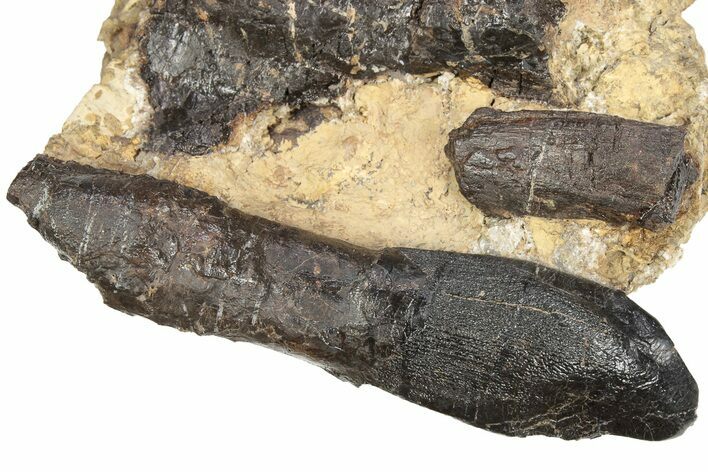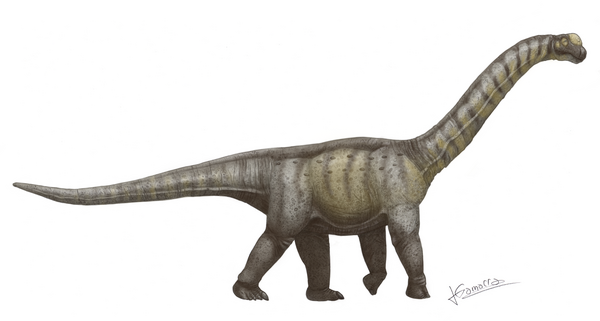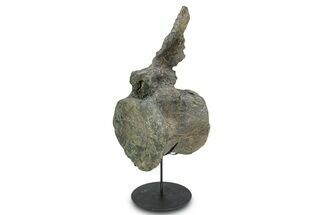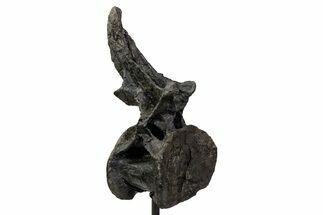4.20" Rooted Dinosaur (Camarasaurus) Tooth w/ Skull Fragment -Colorado
This is a 4.20" long rooted tooth of Camarasaurus, a giant sauropod dinosaur from the Morrison Formation in Colorado. Camarasaurus had very distinctive teeth that were designed for eating coarse vegetation. It is associated with the root of another Camarasaurus tooth and some skull bone fragments. Rooted teeth like this don't become available very often.
There is some minor feeding wear visible at the apical end of the tooth. Crack repair and minor gap fill restoration can be found throughout the root, with some crack repair and gap fill restoration through the crown as well. The majority of restoration through the crown is located about 1/2" from the tip.
It comes with an acrylic display stand.
There is some minor feeding wear visible at the apical end of the tooth. Crack repair and minor gap fill restoration can be found throughout the root, with some crack repair and gap fill restoration through the crown as well. The majority of restoration through the crown is located about 1/2" from the tip.
It comes with an acrylic display stand.
About Camarasaurus
Camarasaurus was a medium-sized sauropod dinosaur whose fossils are found in the Morrison Formation of the Southest United States. It is estimated to have reached lengths of up to 75 feet long and had an estimated maximum weight of around 50 tons. Compared to contemporary Diplodocids, it had a shorter tail, longer forelimbs, and a much larger and more robust skull.
Camarasaurus skulls are quite distinctive: they have blunt snout and quite a square shape. Camarasaurus had large, spoon-shaped teeth, unlike many sauropod dinosaurs that had small, peg-like teeth. This likely indicates that it ate coarser vegetation, allowing it to share the same environment as other sauropods without competing for food. It may have replaced its teeth approximately every 60 days as they became worn from chewing. Its cervical vertebrae had hollow chambers to reduce weight on the neck, leading to its name, which means “chambered lizard”.
Camarasaurus is considered the most abundant of the sauropod dinosaurs found in North America. Its fossils have been found in almost every major Morrison Formation dinosaur locality, with fossils found in localities from across many states including New Mexico, Utah, Colorado, Montana and Oklahoma.
Camarasaurus was a medium-sized sauropod dinosaur whose fossils are found in the Morrison Formation of the Southest United States. It is estimated to have reached lengths of up to 75 feet long and had an estimated maximum weight of around 50 tons. Compared to contemporary Diplodocids, it had a shorter tail, longer forelimbs, and a much larger and more robust skull.
Camarasaurus skulls are quite distinctive: they have blunt snout and quite a square shape. Camarasaurus had large, spoon-shaped teeth, unlike many sauropod dinosaurs that had small, peg-like teeth. This likely indicates that it ate coarser vegetation, allowing it to share the same environment as other sauropods without competing for food. It may have replaced its teeth approximately every 60 days as they became worn from chewing. Its cervical vertebrae had hollow chambers to reduce weight on the neck, leading to its name, which means “chambered lizard”.
Camarasaurus is considered the most abundant of the sauropod dinosaurs found in North America. Its fossils have been found in almost every major Morrison Formation dinosaur locality, with fossils found in localities from across many states including New Mexico, Utah, Colorado, Montana and Oklahoma.
About The Morrison Formation
Located in the midwestern United States, the Late Jurassic-aged Morrison Formation is an incredibly large and fossiliferous formation that dates back to about 156 to 147 million years old. Named after the small town of Morrison, Colorado, the formation was discovered in 1877, and quickly became the center of one of the biggest rivalries in historical paleontology.
19th century paleontologists Othniel Charles Marsh and Edward Drinker Cope spent 15 years making outstanding strides in the discovery of fossils all throughout the American Midwest, but also resorted to unsavory methods in attempts to discredit or ruin the other's work and reputation, including destruction of specimens.
The total area of the formation is roughly 600,000 square miles, but much of that is inaccessible, deeply buried under prairie land and eroded during the formation of the Rocky Mountains. Even so, many outcroppings across the Front Range and upper Midwest allow paleontologists access to a wealth of information from Late Jurassic North America.
Dinosaurs from the region include large allosaurid dinosaurs, such as the eponymous Allosaurus and its larger relative Saurophaganax. Both exceeded 30 feet in length, making them some of the largest carnivores of their time. They competed with the similarly large megalosaurid Torvosaurus, and the somewhat smaller horned ceratosaurid, Ceratosaurus. On the smaller end of the theropod family tree was the raptor-like Ornitholestes.
For herbivores, Stegosaurus guarded their herds with huge, intimidating backplates and formidable tail spikes. Small, early ankylosaurs like Gargoyleosaurus would have fed on the forested understory, smaller in size than the 30+ foot giant Stegosaurids.
However, the Morrison Formation's main attraction were the giant sauropod dinosaurs, some of the most colossal of dinosaurs and largest land animals of all time. Diplodocus, Camarasaurus, Apatosaurus, Brontosaurus, Brachiosaurus, Barosaurus, and Supersaurus all count themselves among these long-necked titans. None of these herbivores would have been less than 50 feet in length at adult size: the largest of their number would have exceeded 100-115 feet in length, and over 40 tons. For so many sauropods to have lived in roughly the same place and time, they all likely developed different feeding and living strategies to minimize competition. Their massive sizes and herds would have defended them well from any of the numerous predators of the Morrison.
Located in the midwestern United States, the Late Jurassic-aged Morrison Formation is an incredibly large and fossiliferous formation that dates back to about 156 to 147 million years old. Named after the small town of Morrison, Colorado, the formation was discovered in 1877, and quickly became the center of one of the biggest rivalries in historical paleontology.
19th century paleontologists Othniel Charles Marsh and Edward Drinker Cope spent 15 years making outstanding strides in the discovery of fossils all throughout the American Midwest, but also resorted to unsavory methods in attempts to discredit or ruin the other's work and reputation, including destruction of specimens.
The total area of the formation is roughly 600,000 square miles, but much of that is inaccessible, deeply buried under prairie land and eroded during the formation of the Rocky Mountains. Even so, many outcroppings across the Front Range and upper Midwest allow paleontologists access to a wealth of information from Late Jurassic North America.
Dinosaurs from the region include large allosaurid dinosaurs, such as the eponymous Allosaurus and its larger relative Saurophaganax. Both exceeded 30 feet in length, making them some of the largest carnivores of their time. They competed with the similarly large megalosaurid Torvosaurus, and the somewhat smaller horned ceratosaurid, Ceratosaurus. On the smaller end of the theropod family tree was the raptor-like Ornitholestes.
For herbivores, Stegosaurus guarded their herds with huge, intimidating backplates and formidable tail spikes. Small, early ankylosaurs like Gargoyleosaurus would have fed on the forested understory, smaller in size than the 30+ foot giant Stegosaurids.
However, the Morrison Formation's main attraction were the giant sauropod dinosaurs, some of the most colossal of dinosaurs and largest land animals of all time. Diplodocus, Camarasaurus, Apatosaurus, Brontosaurus, Brachiosaurus, Barosaurus, and Supersaurus all count themselves among these long-necked titans. None of these herbivores would have been less than 50 feet in length at adult size: the largest of their number would have exceeded 100-115 feet in length, and over 40 tons. For so many sauropods to have lived in roughly the same place and time, they all likely developed different feeding and living strategies to minimize competition. Their massive sizes and herds would have defended them well from any of the numerous predators of the Morrison.
$2,795
SPECIES
Camarasaurus grandis
LOCATION
Moffat County, Colorado
FORMATION
Morrison Formation
SIZE
Tooth: 4.20" long, Entire Specimen: 5.15 x 4.2"
CATEGORY
SUB CATEGORY
ITEM
#240847
We guarantee the authenticity of all of our specimens.
 Reviews
Reviews


















